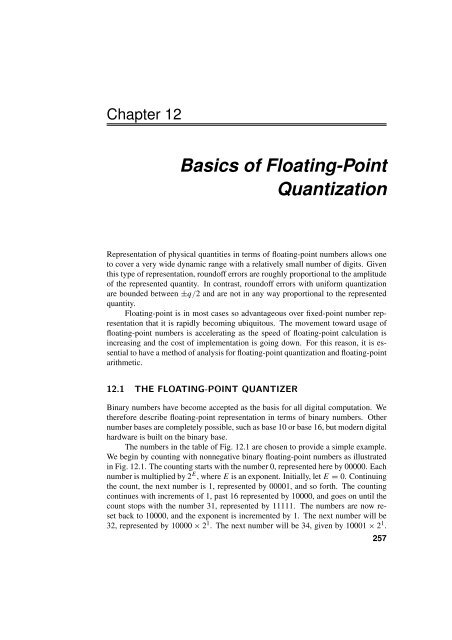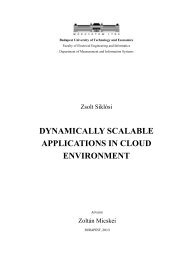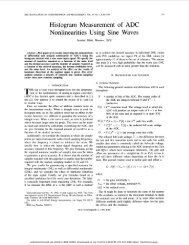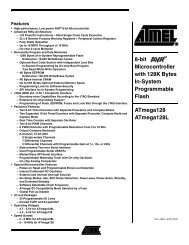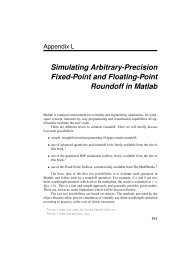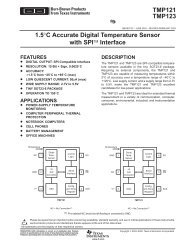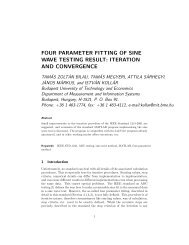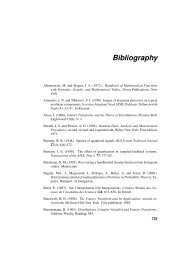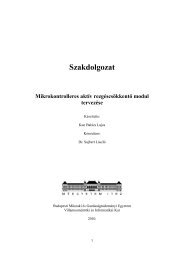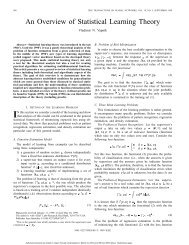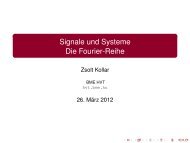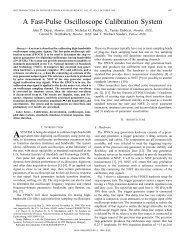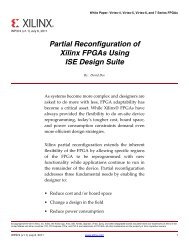Basics of Floating-Point Quantization
Basics of Floating-Point Quantization
Basics of Floating-Point Quantization
You also want an ePaper? Increase the reach of your titles
YUMPU automatically turns print PDFs into web optimized ePapers that Google loves.
Chapter 12<strong>Basics</strong> <strong>of</strong> <strong>Floating</strong>-<strong>Point</strong><strong>Quantization</strong>Representation <strong>of</strong> physical quantities in terms <strong>of</strong> floating-point numbers allows oneto cover a very wide dynamic range with a relatively small number <strong>of</strong> digits. Giventhis type <strong>of</strong> representation, round<strong>of</strong>f errors are roughly proportional to the amplitude<strong>of</strong> the represented quantity. In contrast, round<strong>of</strong>f errors with uniform quantizationare bounded between ±q/2 and are not in any way proportional to the representedquantity.<strong>Floating</strong>-point is in most cases so advantageous over fixed-point number representationthat it is rapidly becoming ubiquitous. The movement toward usage <strong>of</strong>floating-point numbers is accelerating as the speed <strong>of</strong> floating-point calculation isincreasing and the cost <strong>of</strong> implementation is going down. For this reason, it is essentialto have a method <strong>of</strong> analysis for floating-point quantization and floating-pointarithmetic.12.1 THE FLOATING-POINT QUANTIZERBinary numbers have become accepted as the basis for all digital computation. Wetherefore describe floating-point representation in terms <strong>of</strong> binary numbers. Othernumber bases are completely possible, such as base 10 or base 16, but modern digitalhardware is built on the binary base.The numbers in the table <strong>of</strong> Fig. 12.1 are chosen to provide a simple example.We begin by counting with nonnegative binary floating-point numbers as illustratedin Fig. 12.1. The counting starts with the number 0, represented here by 00000. Eachnumber is multiplied by 2 E ,whereE is an exponent. Initially, let E = 0. Continuingthe count, the next number is 1, represented by 00001, and so forth. The countingcontinues with increments <strong>of</strong> 1, past 16 represented by 10000, and goes on until thecount stops with the number 31, represented by 11111. The numbers are now resetback to 10000, and the exponent is incremented by 1. The next number will be32, represented by 10000 × 2 1 . The next number will be 34, given by 10001 × 2 1 .257
258 12 <strong>Basics</strong> <strong>of</strong> <strong>Floating</strong>-<strong>Point</strong> <strong>Quantization</strong>Mantissa0 0 0 0 0 01 0 0 0 0 12 0 0 0 1 03 0 0 0 1 14 0 0 1 0 05 0 0 1 0 16 0 0 1 1 07 0 0 1 1 18 0 1 0 0 09 0 1 0 0 110 0 1 0 1 011 0 1 0 1 112 0 1 1 0 013 0 1 1 0 114 0 1 1 1 015 0 1 1 1 116 −→ 1 0 0 0 017 1 0 0 0 118 1 0 0 1 019 1 0 0 1 120 1 0 1 0 021 1 0 1 0 122 1 0 1 1 023 1 0 1 1 124 1 1 0 0 025 1 1 0 0 126 1 1 0 1 027 1 1 0 1 128 1 1 1 0 029 1 1 1 0 130 1 1 1 1 031 ←− 1 1 1 1 1⎫⎪⎬×2 E⎪⎭Figure 12.1 Counting with binary floating-point numbers with 5-bit mantissa. No sign bitis included here.
12.1 The <strong>Floating</strong>-<strong>Point</strong> Quantizer 259xQx ′FLFigure 12.2 A floating-point quantizer.This will continue with increments <strong>of</strong> 2 until the number 62 is reached, representedby 11111 × 2 1 . The numbers are again re-set back to 10000, and the exponent isincremented again. The next number will be 64, given by 10000 × 2 2 . And s<strong>of</strong>orth. By counting, we have defined the allowed numbers on the number scale. Eachnumber consists <strong>of</strong> a mantissa (see page 343) multiplied by 2 raised to a power givenby the exponent E.The counting process illustrated in Fig. 12.1 is done with binary numbers having5-bit mantissas. The counting begins with binary 00000 with E = 0 and goes upto 11111, then the numbers are recycled back to 10000, and with E = 1, the countingresumes up to 11111, then the numbers are recycled back to 10000 again withE = 2, and the counting proceeds.A floating-point quantizer is represented in Fig. 12.2. 1 The input to this quantizeris x, a variable that is generally continuous in amplitude. The output <strong>of</strong> thisquantizer is x ′ , a variable that is discrete in amplitude and that can only take on valuesin accord with a floating-point number scale. The input–output relation for thisquantizer is a staircase function that does not have uniform steps.Figure 12.3 illustrates the input–output relation for a floating-point quantizerwith a 3-bit mantissa. The input physical quantity is x. Its floating-point representationis x ′ . The smallest step size is q. With a 3-bit mantissa, four steps are takenfor each cycle, except for eight steps taken for the first cycle starting at the origin.The spacings <strong>of</strong> the cycles are determined by the choice <strong>of</strong> a parameter . A generalrelation between and q, defining , is given by Eq. (12.1): = △ 2 p q , (12.1)where p is the number <strong>of</strong> bits <strong>of</strong> the mantissa. With a 3-bit mantissa, = 8q.Figure 12.3 is helpful in gaining an understanding <strong>of</strong> relation (12.1). Note that afterthe first cycle, the spacing <strong>of</strong> the cycles and the step sizes vary by a factor <strong>of</strong> 2 fromcycle to cycle.1 The basic ideas and figures <strong>of</strong> the next sections were first published in, and are taken with permissionfrom Widrow, B., Kollár, I. and Liu, M.-C., ”Statistical theory <strong>of</strong> quantization,” IEEE Transactionson Instrumentation and Measurement 45(6): 35361. c○1995 IEEE.
260 12 <strong>Basics</strong> <strong>of</strong> <strong>Floating</strong>-<strong>Point</strong> <strong>Quantization</strong>4x ′2Average gain = 1x−4 −2 − 2 4−−22qx ′q−4− 3q 2 − q 2q2−q3q2x−2qFigure 12.3 Input–output staircase function for a floating-point quantizer with a 3-bit mantissa.x xQ ′InputFLOutput− +ν FLFigure 12.4 <strong>Floating</strong>-point quantization noise.12.2 FLOATING-POINT QUANTIZATION NOISEThe round<strong>of</strong>f noise <strong>of</strong> the floating-point quantizer ν FL is the difference between thequantizer output and input:ν FL = x ′ − x . (12.2)Figure 12.4 illustrates the relationships between x, x ′ ,andν FL .
12.3 An Exact Model <strong>of</strong> the <strong>Floating</strong>-<strong>Point</strong> Quantizer 26112108f νFL6420−2 −1.5 −1 −0.5 0 0.5 1 1.5ν FL2Figure 12.5 The PDF <strong>of</strong> floating-point quantization noise with a zero-mean Gaussian input,σ x = 32, and with a 2-bit mantissa.The PDF <strong>of</strong> the quantization noise can be obtained by slicing and stacking thePDF <strong>of</strong> x, as was done for the uniform quantizer and illustrated in Fig. 5.2. Becausethe staircase steps are not uniform, the PDF <strong>of</strong> the quantization noise is not uniform.It has a pyramidal shape.With a zero-mean Gaussian input with σ x = 32, and with a mantissa havingjust two bits, the quantization noise PDF has been calculated. It is plotted inFig. 12.5. The shape <strong>of</strong> this PDF is typical. The narrow segments near the top <strong>of</strong>the pyramid are caused by the occurrence <strong>of</strong> values <strong>of</strong> x that are small in magnitude(small quantization step sizes), while the wide segments near the bottom <strong>of</strong> the pyramidare caused by the occurrence <strong>of</strong> values <strong>of</strong> x that are large in magnitude (largequantization step sizes).The shape <strong>of</strong> the PDF <strong>of</strong> floating-point quantization noise resembles the silhouette<strong>of</strong> a big-city “skyscraper” like the famous Empire State Building <strong>of</strong> New YorkCity. We have called functions like that <strong>of</strong> Fig. 12.5 “skyscraper PDFs”. Mathematicalmethods will be developed next to analyze floating-point quantization noise, t<strong>of</strong>ind its mean and variance, and the correlation coefficient between this noise and theinput x.12.3 AN EXACT MODEL OF THE FLOATING-POINTQUANTIZERA floating-point quantizer <strong>of</strong> the type shown in Fig. 12.3 can be modeled exactly as acascade <strong>of</strong> a nonlinear function (a “compressor”) followed by a uniform quantizer (a“hidden” quantizer) followed by an inverse nonlinear function (an “expander”). The
262 12 <strong>Basics</strong> <strong>of</strong> <strong>Floating</strong>-<strong>Point</strong> <strong>Quantization</strong>x yy ′x ′CompressorExpanderQNonlinearfunctionUniform quantizer(“Hidden quantizer”)(a)Inversenonlinearfunctionx x ′CompressorExpanderQy− +νy ′− +ν FL(b)Figure 12.6 A model <strong>of</strong> a floating-point quantizer: (a) block diagram; (b) definition <strong>of</strong>quantization noises.overall idea is illustrated in Fig. 12.6(a). A similar idea is <strong>of</strong>ten used to representcompression and expansion in a data compression system (see e.g. Gersho and Gray(1992), CCITT (1984)).The input–output characteristic <strong>of</strong> the compressor (y vs. x) is shown in Fig. 12.7,and the input–output characteristic <strong>of</strong> the expander (x ′ vs. y ′ ) is shown in Fig. 12.8.The hidden quantizer is conventional, having a uniform-staircase input–output characteristic(y ′ vs. y). Its quantization step size is q, and its quantization noise isν = y ′ − y . (12.3)Figure 12.6(b) is a diagram showing the sources <strong>of</strong> ν FL and ν. An expression for theinput–output characteristic <strong>of</strong> the compressor is
12.3 An Exact Model <strong>of</strong> the <strong>Floating</strong>-<strong>Point</strong> Quantizer 263y = x,if − ≤ x ≤ y = 1 2 x + 1 2, if ≤ x ≤ 2y = 1 2 x − 1 2 , if − 2 ≤ x ≤−y = 1 4x + , if 2 ≤ x ≤ 4y = 1 4 x − , if − 4 ≤ x ≤−2.y = 1 x + k 2 k 2 , if 2k−1 ≤ x ≤ 2 k y = 1 x − k 2 k 2 , if − 2k ≤ x ≤−2 k−1 ory = 1 x + sign(x) · k22 , if k 2k−1 ≤|x| ≤2 k ,where k is a nonnegative integer. This is a piecewise-linear characteristic.An expression for the input–output characteristic <strong>of</strong> the expander isx ′ = y ′ ,if − ≤ y ′ ≤ x ′ = 2(y ′ − 0.5), if ≤ y ′ ≤ 1.5x ′ = 2(y ′ − 0.5), if − 1.5 ≤ y ′ ≤−x ′ = 4(y ′ − ), if 1.5 ≤ y ′ ≤ 2x ′ = 4(y ′ + ), if − 2 ≤ y ′ ≤−1.5.x ′ = 2 k (y ′ − k 2 ), if k+12 ≤ y′ ≤ k+2x ′ = 2 k (y ′ + k 22 ), if −k+22 ≤ y′ ≤− k+12 orx ′ = 2 k (y ′ − sign(y) · k2 ), if k+12 ≤|y′ |≤ k+2(12.4)2 , (12.5)where k is a nonnegative integer. This characteristic is also piecewise linear.One should realize that the compressor and expander characteristics describedabove are universal and are applicable for any choice <strong>of</strong> mantissa size.The compressor and expander characteristics <strong>of</strong> Figs. 12.7 and 12.8 are drawnto scale. Fig. 12.9 shows the characteristic (y ′ vs. y) <strong>of</strong> the hidden quantizer drawnto the same scale, assuming a mantissa <strong>of</strong> 2 bits. For this case, = 4q.If only the compressor and expander were cascaded, the result would be a perfectgain <strong>of</strong> unity since they are inverses <strong>of</strong> each other. If the compressor is cascadedwith the hidden quantizer <strong>of</strong> Fig. 12.9 and then cascaded with the expander, all inaccord with the diagram <strong>of</strong> Fig. 12.6, the result is a floating-point quantizer. The oneillustrated in Fig. 12.10 has a 2-bit mantissa.The cascaded model <strong>of</strong> the floating-point quantizer shown in Fig. 12.6 becomesvery useful when the quantization noise <strong>of</strong> the hidden quantizer has the properties <strong>of</strong>
264 12 <strong>Basics</strong> <strong>of</strong> <strong>Floating</strong>-<strong>Point</strong> <strong>Quantization</strong>4321y/0−1−2−3−4−4 −3 −2 −1 0 1 2 3 4x/Figure 12.7 The compressor’s input–output characteristic.4321x ′ /0−1−2−3−4−4 −3 −2 −1 0 1 2 3 4y ′ /Figure 12.8 The expander’s input–output characteristic.
12.3 An Exact Model <strong>of</strong> the <strong>Floating</strong>-<strong>Point</strong> Quantizer 2654321y ′ /0−1−2−3−4−4 −3 −2 −1 0 1 2 3 4y/Figure 12.9 The uniform “hidden quantizer.” The mantissa has 2 bits.4321x ′ /0−1−2−3−4−4 −3 −2 −1 0 1 2 3 4x/Figure 12.10 A floating-point quantizer with a 2-bit mantissa.
266 12 <strong>Basics</strong> <strong>of</strong> <strong>Floating</strong>-<strong>Point</strong> <strong>Quantization</strong>PQN. This would happen if QT I or QT II were satisfied at the input y <strong>of</strong> the hiddenquantizer. Testing for the satisfaction <strong>of</strong> these quantizing theorems is complicatedby the nonlinearity <strong>of</strong> the compressor. If x were a Gaussian input to the floatingpointquantizer, the input to the hidden quantizer would be x mapped through thecompressor. The result would be a non-Gaussian input to the hidden quantizer.In practice, inputs to the hidden quantizer almost never perfectly meet the conditionsfor satisfaction <strong>of</strong> a quantizing theorem. On the other hand, these inputsalmost always satisfy these conditions approximately. The quantization noise ν introducedby the hidden quantizer is generally very close to uniform and very close tobeing uncorrelated with its input y. The PDF <strong>of</strong> y is usually sliced up so finely thatthe hidden quantizer produces noise having properties like PQN.12.4 HOW GOOD IS THE PQN MODEL FOR THE HIDDENQUANTIZER?In previous chapters where uniform quantization was studied, it was possible to defineproperties <strong>of</strong> the input CF that would be necessary and sufficient for the satisfaction<strong>of</strong> a quantizing theorem, such as QT II. Even if these conditions were notobtained, as for example with a Gaussian input, it was possible to determine the errorsthat would exist in moment prediction when using the PQN model. These errorswould almost always be very small.For floating-point quantization, the same kind <strong>of</strong> calculations for the hiddenquantizer could in principle be made, but the mathematics would be far more difficultbecause <strong>of</strong> the action <strong>of</strong> the compressor on the input signal x. The distortion <strong>of</strong> thecompressor almost never simplifies the CF <strong>of</strong> the input x nor makes it easy to test forthe satisfaction <strong>of</strong> a quantizing theorem.To determine the statistical properties <strong>of</strong> ν, the PDF <strong>of</strong> the input x can bemapped through the piecewise-linear compressor characteristic to obtain the PDF<strong>of</strong> y. In turn, y is quantized by the hidden quantizer, and the quantization noise νcan be tested for similarity to PQN. The PDF <strong>of</strong> ν can be determined directly fromthe PDF <strong>of</strong> y, or it could be obtained by Monte Carlo methods by applying randomx inputs into the compressor and observing corresponding values <strong>of</strong> y and ν. Themoments <strong>of</strong> ν can be determined, and so can the covariance between ν and y. ForthePQN model to be usable, the covariance <strong>of</strong> ν and y should be close to zero, less thana few percent, the PDF <strong>of</strong> ν should be almost uniform between ±q/2, and the mean<strong>of</strong> ν should be close to zero while the mean square <strong>of</strong> ν should be close to q 2 /12.In many cases with x being Gaussian, the PDF <strong>of</strong> the compressor output y canbe very “ugly.” Examples are shown in Figs. 12.11(a)–12.14(a). These representcases where the input x is Gaussian with various mean values and various ratios <strong>of</strong>σ x /. With mantissas <strong>of</strong> 4 bits or more, these ugly inputs to the hidden quantizercause it to produce quantization noise which behaves remarkably like PQN. Thisis difficult to prove analytically, but confirming results from slicing and stacking
12.4 How Good is the PQN Model for the Hidden Quantizer? 2670.250.200.15f y (y)0.100.050−6 −5 −4 −3 −2 −1(a)f ν (ν)1/q0 1 2 3 4 5 6y/f ν (ν)1/qq = 16q =256(b)−q/2 q/2ν(c)−q/2 q/2νFigure 12.11 PDF <strong>of</strong> compressor output and <strong>of</strong> hidden quantization noise when x is zeromeanGaussian with σ x = 50: (a)f y (y); (b)f ν (ν) for p = 4(q = /16); (c) f ν (ν) forp = 8(q = /256).these PDFs are very convincing. Similar techniques have been used with these PDFsto calculate correlation coefficients between ν and y. The noise ν turns out to beessentially uniform, and the correlation coefficient turns out to be essentially zero.Consider the ugly PDF <strong>of</strong> y shown in Fig. 12.11(a), f y (y). The horizontal scalegoes over a range <strong>of</strong> ±5. If we choose a mantissa <strong>of</strong> 4 bits, the horizontal scale willcover the range ±80q. If we choose a mantissa <strong>of</strong> 8 bits, q will be much smaller andthe horizontal scale will cover the range ±1280q. With the 4-bit mantissa, slicing andstacking this PDF to obtain the PDF <strong>of</strong> ν, we obtain the result shown in Fig. 12.11(b).From the PDF <strong>of</strong> ν, we obtain a mean value <strong>of</strong> 1.048 · 10 −6 q, and a mean square <strong>of</strong>0.9996q 2 /12. The correlation coefficient between ν and y is (1.02 · 10 −3 ). Withan 8-bit mantissa, f ν (ν) shown in Fig. 12.11c is even more uniform, giving a meanvalue for ν <strong>of</strong> −9.448 · 10 −9 q, and a mean square <strong>of</strong> 1.0001q 2 /12. The correlation
268 12 <strong>Basics</strong> <strong>of</strong> <strong>Floating</strong>-<strong>Point</strong> <strong>Quantization</strong>0.50.4f y (y)0.30.20.10−2 −1.5 −1 −0.5(a)f ν (ν)1/q0 0.5 1 1.5 2y/f ν (ν)1/qq = 16q =256(b)−q/2 q/2ν(c)−q/2 q/2νFigure 12.12 PDF <strong>of</strong> compressor output and <strong>of</strong> hidden quantization noise when xis Gaussian with σ x = /2 andμ x = σ x : (a) f y (y); (b) f ν (ν) for 4-bit mantissas,(q = /16); (c) f ν (ν) for 8-bit mantissas, (q = /256).
12.4 How Good is the PQN Model for the Hidden Quantizer? 2690.50.4f y (y)0.30.20.10−6 −5 −4 −3 −2 −1(a)f ν (ν)1/q0 1 2 3 4 5 6y/f ν (ν)1/qq = 16q =256(b)−q/2 q/2ν(c)−q/2 q/2νFigure 12.13 PDF <strong>of</strong> compressor output and <strong>of</strong> hidden quantization noise when xis Gaussian with σ x = 50 and μ x = σ x : (a) f y (y); (b) f ν (ν) for 4-bit mantissas,(q = /16); (c) f ν (ν) for 8-bit mantissas, (q = /256).
270 12 <strong>Basics</strong> <strong>of</strong> <strong>Floating</strong>-<strong>Point</strong> <strong>Quantization</strong>f y (y)43.532.521.510.50 5 5.25 5.5 5.75 6(a)y/f ν (ν)f ν (ν)1/q1/qq = 16q =256(b)−q/2 q/2ν(c)−q/2 q/2νFigure 12.14 PDF <strong>of</strong> compressor output and <strong>of</strong> hidden quantization noise when x isGaussian with σ x = 50 and μ x = 10σ x = 500: (a)f y (y); (b)f ν (ν) for 4-bit mantissas,(q = /16); (c) f ν (ν) for 8-bit mantissas, (q = /256).
12.4 How Good is the PQN Model for the Hidden Quantizer? 271TABLE 12.1 Properties <strong>of</strong> the hidden quantization noise ν for Gaussian input(a) p = 4 E{ν}/q E{ν 2 }/(q 2 /12) ρ y,νμ x = 0, σ x = 50 0.0002 0.9997 0.0140μ x = σ x ,σ x = 0.5 −0.0015 0.9998 −0.0069μ x = σ x ,σ x = 50 −0.0019 0.9994 −0.0089μ x = σ x ,σ x = 500 −0.0023 0.9987 −0.0077(b) p = 8 E{ν}/q E{ν 2 }/(q 2 /12) ρ y,νμ x = 0, σ x = 50 4.25 · 10 −5 0.9995 8.68 · 10 −4μ x = σ x ,σ x = 0.5 −2.24 · 10 −4 1.0005 −2.35 · 10 −4μ x = σ x ,σ x = 50 −3.72 · 10 −4 0.9997 −1.30 · 10 −3μ x = σ x ,σ x = 500 −1.92 · 10 −4 0.9985 −8.77 · 10 −4coefficient between ν and y is (2.8 · 10 −4 ). With a mantissa <strong>of</strong> four bits or more, thenoise ν behaves very much like PQN.This process was repeated for the ugly PDFs <strong>of</strong> Figs. 12.12(a), 12.13(a), and12.14(a). The corresponding PDFs <strong>of</strong> the quantization noise <strong>of</strong> the hidden quantizerare shown in Figs. 12.12(b), 12.13(b), and 12.14(b). With a 4-bit mantissa,Table 12.1(a) lists the values <strong>of</strong> mean and mean square <strong>of</strong> ν, and correlation coefficientbetween ν and y for all the cases. With an 8-bit mantissa, the correspondingmoments are listed in Table 12.1(b).Similar tests have been made with uniformly distributed inputs, with triangularlydistributed inputs, and with sinusoidal inputs. Input means ranged from zero toone standard deviation. The moments <strong>of</strong> Tables 12.1(a),(b) are typical for Gaussianinputs, but similar results are obtained with other forms <strong>of</strong> inputs.For every single test case, the input x had a PDF that extended over at leastseveral multiples <strong>of</strong> . With a mantissa <strong>of</strong> 8 bits or more, the noise <strong>of</strong> the hiddenquantizer had a mean <strong>of</strong> almost zero, a mean square <strong>of</strong> almost q 2 /12, and a correlationcoefficient with the quantizer input <strong>of</strong> almost zero.The PQN model works so well that we assume that it is true as long as themantissa has 8 or more bits and the PDF <strong>of</strong> x covers at least several -quanta <strong>of</strong> thefloating-point quantizer. It should be noted that the single precision IEEE standard(see Section 13.8) calls for a mantissa with 24 bits. When working with this standard,the PQN model will work exceedingly well almost everywhere.
272 12 <strong>Basics</strong> <strong>of</strong> <strong>Floating</strong>-<strong>Point</strong> <strong>Quantization</strong>12.5 ANALYSIS OF FLOATING-POINT QUANTIZATIONNOISEWe will use the model <strong>of</strong> the floating-point quantizer shown in Fig. 12.6 to determinethe statistical properties <strong>of</strong> ν FL . We will derive its mean, its mean square, and itscorrelation coefficient with input x.The hidden quantizer injects noise into y, resulting in y ′ , which propagatesthrough the expander to make x ′ . Thus, the noise <strong>of</strong> the hidden quantizer propagatesthrough the nonlinear expander into x ′ . The noise in x ′ is ν FL .Assume that the noise ν <strong>of</strong> the hidden quantizer is small compared to y. Thenν is a small increment to y. This causes an increment ν FL at the expander output.Accordingly,( dx′ν FL = ν . (12.6)dy ′ )yThe derivative is a function <strong>of</strong> y. This is because the increment ν is added to y, soyis the nominal point where the derivative should be taken.Since the PQN model was found to work so well for so many cases with regardto the behavior <strong>of</strong> the hidden quantizer, we will make the assumption that the conditionsfor PQN are indeed satisfied for the hidden quantizer. This greatly simplifiesthe statistical analysis <strong>of</strong> ν FL .Expression (12.6) can be used in the following way to find the crosscorrelationbetween ν FL and input x.{ ( }dx′E{ν FL x}=E ν · · x= E {ν} Edy ′ )y{ (dx′dy ′ )y= 0 . (12.7)When deriving this result, it was possible to factor the expectation into a product<strong>of</strong> expectations because, from the point <strong>of</strong> view <strong>of</strong> moments, ν( behaves as if it isindependent <strong>of</strong> y and independent <strong>of</strong> any function <strong>of</strong> y, suchas dx ′dy)y ′ and x. Sincethe expected value <strong>of</strong> ν is zero, the crosscorrelation turns out to be zero.Expression (12.6) can also be used to find the mean <strong>of</strong> ν FL . Accordingly,{ ( }dx′E{ν FL }=E ν ·= E{ν}Edy ′ )y{ (dx′dy ′ )y· x}}= 0 . (12.8)
12.5 Analysis <strong>of</strong> <strong>Floating</strong>-<strong>Point</strong> <strong>Quantization</strong> Noise 273So the mean <strong>of</strong> ν FL is zero, and the crosscorrelation between ν FL and x is zero. Bothresults are consequences <strong>of</strong> the hidden quantizer behaving in accord with the PQNmodel.Our next(objective is the determination <strong>of</strong> E{ν 2 FL}. We will need to find an expressionfor dx ′dy)y ′ in order to obtain quantitative results. By inspection <strong>of</strong> Figs. 12.7and 12.8, which show the characteristics <strong>of</strong> the compressor and the expander, we determinethatdx ′dy ′ = 1 when 0.5
274 12 <strong>Basics</strong> <strong>of</strong> <strong>Floating</strong>-<strong>Point</strong> <strong>Quantization</strong>3.5log 2( x)+ 0.52.51.50.5−0.50 2 3 4 5 6 7 8(a)( ( x) )Q 1 log 2 + 0.54x32100 2 3 4 5 6 7 8(b)xFigure 12.15 Approximate and ( exact exponent characteristics: )(a) logarithmic approximation;(b) exact expression, Q 1 log 2 (x/) + 0.5 vs. x.
12.5 Analysis <strong>of</strong> <strong>Floating</strong>-<strong>Point</strong> <strong>Quantization</strong> Noise 275Referring back to (12.9), it is apparent that for positive values <strong>of</strong> x, the derivativecan be represented in terms <strong>of</strong> the new function as( x) )dx′= 2 Q 1((log 2 + 0.5 , x >/2 . (12.11)dy ′ )xFor negative values <strong>of</strong> x, the derivative is((( −xdx′ Q 1 log 2= 2 dy ′ )xAnother way to write this is( dx′dy ′ )x((|x|Q 1 log 2= 2 ) )+ 0.5) )+ 0.5These are exact expressions for the derivative.From Eqs. (12.13) and Eq. (12.6), we obtain ν FL as, x < −/2 . (12.12), |x| >/2 . (12.13)(( ) )|x|Q 1 log 2 + 0.5ν FL = ν · 2 , |x| >/2 . (12.14)One should note that the value <strong>of</strong> would generally be much smaller than the value<strong>of</strong> x. At the input level <strong>of</strong> |x|
276 12 <strong>Basics</strong> <strong>of</strong> <strong>Floating</strong>-<strong>Point</strong> <strong>Quantization</strong>= √ 2ν · |x| 2ν EXP. (12.17)The mean square <strong>of</strong> ν FL can be obtained from this.{ }E{ν 2 }=2E FLν 2 x2 2 22ν EXP{ x= 2E{ν 2 2}}E. (12.18) 2 22ν EXPThe factorization is permissible because by assumption ν behaves as PQN. The noiseν EXP is related to x, but since ν EXP is bounded, it is possible to upper and lower boundE{ν 2 } even without knowledge <strong>of</strong> the relation between ν FL EXP and x. The bounds areE{ν 2 }E{ x2 2 }≤E{ν2 FL }≤4E{ν2 }E{ x2 2 }. (12.19)). From the point <strong>of</strong> view <strong>of</strong> moments, ν EXP will behave as if it isThese bounds hold without exception as long as the PQN model applies for the hiddenquantizer.If, in addition to this, the PQN model applies to the quantized exponent inEq. (12.15), then a precise value for E{ν 2 } can be obtained. With PQN, ν FL EXP willhave zero mean, a mean square <strong>of</strong> 1/12, a mean fourth <strong>of</strong> 1/80, and will be uncorre-(lated with log |x|2 independent <strong>of</strong> x and any function <strong>of</strong> x. From Eq. (12.17),ν FL = √ 2 · ν · |x| 2ν EXP= √ 2 · ν · |x| eν EXP ln 2 . (12.20)From this, we can obtain E{ν 2 }: FL{E{ν 2 }=2E FLν 2 x2 2 e2ν EXP ln 2 }= 2E{ν 2 x2 ( 2 1 + 2ν EXP ln 2 + 1 2! (2ν EXP ln 2) 2 + 1 3! (2ν EXP ln 2) 3+ 1 ) }4! (2ν EXP ln 2) 4 +···{ x= E{ν 2 2} {}E 2 E 2 + 4ν EXP ln 2 + 4ν 2 (ln EXP 2)2 + 8 3 ν3 EXP(ln 2)3+ 4 }3 ν4 (ln EXP 2)4 +··· . (12.21)Since the odd moments <strong>of</strong> ν EXP are all zero,{ xE{ν 2 2}(FL }=E{ν2 }E 2 2 + 4( 112 )(ln 2)2 + ( 4 3 )( 1)80 )(ln 2)4 +···
12.5 Analysis <strong>of</strong> <strong>Floating</strong>-<strong>Point</strong> <strong>Quantization</strong> Noise 277{ x= 2.16 · E{ν 2 2}}E 2 . (12.22)This falls about half way between the lower and upper bounds.A more useful form <strong>of</strong> this expression can be obtained by substituting the following,E{ν 2 }= q212 , and q = 2−p . (12.23)The result is a very important one:E{ν 2 }=0.180 · FL 2−2p · E{x 2 } . (12.24)Example 12.1 Round<strong>of</strong>f noise when multiplying two floating-point numbersLet us assume that two numbers: 1.34 · 10 −3 and 4.2 are multiplied using IEEEdouble precision arithmetic. The exact value <strong>of</strong> the round<strong>of</strong>f error could be determinedby using the result <strong>of</strong> more precise calculation (with p > 53) as areference. However, this is usually not available.The mean square <strong>of</strong> the round<strong>of</strong>f noise can be easily determined using Eq. (12.24),without the need <strong>of</strong> reference calculations. The product equals 5.63·10 −3 . Whentwo numbers <strong>of</strong> magnitudes similar as above are multiplied, the round<strong>of</strong>f noisewill have a mean square <strong>of</strong> E{ν 2 }≈0.180 · FL 2−2p · 3.2 · 10 −5 . Although wecannot determine the precise round<strong>of</strong>f error value for the given case, we can giveits expected magnitude.Example 12.2 Round<strong>of</strong>f noise in 2nd-order IIR filtering with floating pointLet us assume one evaluates the recursive formulay(n) =−a(1)y(n − 1) − a(2)y(n − 2) + b(1)x(n − 1).When the operations (multiplications and additions) are executed in natural order,all with precision p, the following sources <strong>of</strong> arithmetic round<strong>of</strong>f can beenumerated:1. round<strong>of</strong>f after the multiplication a(1)y(n − 1):var{ν FL1 }≈0.180 · 2 −2p · a(1) 2 · var{y},2. round<strong>of</strong>f after the storage <strong>of</strong> −a(1)y(n − 1):var{ν FL2 }=0, since if the product in item 1 is rounded, the quantity to bestored is already quantized,3. round<strong>of</strong>f after the multiplication a(2)y(n − 2):var{ν FL3 }≈0.180 · 2 −2p · a(2) 2 · var{y},4. round<strong>of</strong>f after the addition −a(1)y(n − 1) − a(2)y(n − 2):var{ν FL4 }≈0.180 · 2 −2p ( a(1) 2 · var{y}+a(2) 2 · var{y}+2a(1)a(2) · C yy (1) ) ,5. round<strong>of</strong>f after the storage <strong>of</strong> −a(1)y(n − 1) − a(2)y(n − 2):var{ν FL5 }=0, since if the product in item 4 is rounded, the quantity to bestored is already quantized,
278 12 <strong>Basics</strong> <strong>of</strong> <strong>Floating</strong>-<strong>Point</strong> <strong>Quantization</strong>6. round<strong>of</strong>f after the multiplication b(1)x(n − 1):var{ν FL6 }≈0.180 · 2 −2p · b(1) 2 · var{x},7. round<strong>of</strong>f after the last addition:var{ν FL7 }≈0.180 · 2 −2p · var{y},8. round<strong>of</strong>f after the storage <strong>of</strong> the result to y(n):var{ν FL8 }=0, since if the sum in item 7 is rounded, the quantity to bestored is already quantized.These variances need to be added to obtain the total variance <strong>of</strong> the arithmeticround<strong>of</strong>f noise injected to y in each step.The total noise variance in y can be determined then by adding the effect <strong>of</strong> eachinjected noise. This can be done using the response to an impulse injected toy(0): ifthisisgivenbyh yy (0), h yy (1),..., including the unit impulse itself attime 0, the variance <strong>of</strong> the total round<strong>of</strong>f noise can be calculated by multiplying∑the above variance <strong>of</strong> the injected noise by ∞ h 2 yy (n).For all these calculations, one also needs to determine the variance <strong>of</strong> y, and theone-step covariance C yy (1).If x is sinusoidal with amplitude A, y is also sinusoidal with an amplitude determinedby the transfer function: var{y} =|H( f 1 )| 2 var{x} =|H( f 1 )| 2 A 2 /2.C yy (1) ≈ var{y} for low-frequency sinusoidal input.∑If x is zero-mean white noise, var{y} =var{x} ∞ h 2 (n), with h(n) being then=0∑impulse response from x to y. The covariance is about var{x} ∞ h(n)h(n + 1).Numerically, let us use single precision (p = 24), and let a(1) =−0.9, a(2) =0.5, and b(1) = 0.2, and let the input signal be a sine wave with unit power(A 2 /2 = 1), and frequency f 1 = 0.015 f s . With these, H( f 1 ) = 0.33, andvar{y} =0.11, and the covariance C yy (1) approximately equals var{y}. Evaluatingthe variance <strong>of</strong> the floating-point noise,8∑var{ν FL }= var{ν FLn }≈1.83 · 10 −16 . (12.25)n=1The use <strong>of</strong> extended-precision accumulator and <strong>of</strong> multiply-and-add operationIn many modern processors, an accumulator is used with extended precisionp acc , and multiply-and-add operation (see page 374) can be applied. In thiscase, multiplication is usually executed without round<strong>of</strong>f, and additions are notfollowed by extra storage, therefore round<strong>of</strong>f happens only for certain items (but,in addition to the above, var{ν FL2 } ̸= 0, since ν FL1 = 0). The total variance <strong>of</strong> y,caused by arithmetic round<strong>of</strong>f, isvar inj = var{ν FL2 }+var{ν FL4 }+var{ν FL7 }+var{ν FL8 }= 0.180 · 2 −2p acc· a(1) 2 var{y}n=0n=0
12.5 Analysis <strong>of</strong> <strong>Floating</strong>-<strong>Point</strong> <strong>Quantization</strong> Noise 279()+ 0.180 · 2 −2p acca(1) 2 var{y}+a(2) 2 var{y}+2a(1)a(2)C yy (1)+ 0.180 · 2 −2p acc· var{y}+ 0.180 · 2 −2p · var{y} . (12.26)In this expression, usually the last term dominates. With the numerical data,var{ν FL-ext} ≈7.1 · 10 −17 .Making the same substitution in Eq. (12.19), the bounds are112 · 2−2p · E{x 2 }≤E{ν 2 FL }≤1 3 · 2−2p · E{x 2 } . (12.27)The signal-to-noise ratio for the floating-point quantizer is defined asSNR = △ E{x2 }E{νFL} 2 . (12.28)If both ν and ν EXP obey PQN models, then Eq. (12.24) can be used to obtain the SNR.The result is:SNR = 5.55 · 2 2p . (12.29)This is the ratio <strong>of</strong> signal power to quantization noise power. Expressed in dB, theSNR isSNR, dB ≈ 10 log((5.55)2 2p)= 7.44 + 6.02p . (12.30)If only ν obeys a PQN model, then Eq. (12.27) can be used to bound the SNR:12 · 2 2p ≥ SNR ≥ 3 · 2 2p . (12.31)This can be expressed in dB as:4.77 + 6.02p ≤ SNR, dB ≤ 10.79 + 6.02p . (12.32)From relations Eq. (12.29) and Eq. (12.31), it is clear that the SNR improves as thenumber <strong>of</strong> bits in the mantissa is increased. It is also clear that for the floatingpointquantizer, the SNR does not depend on E{x 2 } (as long as ν and ν EXP act likePQN). The quantization noise power is proportional to E{x 2 }. This is a very differentsituation from that <strong>of</strong> the uniform quantizer, where SNR increases in proportion toE{x 2 } since the quantization noise power is constant at q 2 /12.When ν satisfies a PQN model, ν FL is uncorrelated with x. The floating-pointquantizer can be replaced for purposes <strong>of</strong> least-squares analysis by an additive independentnoise having a mean <strong>of</strong> zero and a mean square bounded by (12.27). If in ad-
280 12 <strong>Basics</strong> <strong>of</strong> <strong>Floating</strong>-<strong>Point</strong> <strong>Quantization</strong>dition ν EXP satisfies a PQN model, the mean square <strong>of</strong> ν will be given by Eq. (12.24).Section 12.6 discusses the question about ν EXP satisfying a PQN model. This doeshappen in a surprising number <strong>of</strong> cases. But when PQN fails for ν EXP , we cannotobtain E{ν 2 FL} from Eq. (12.24), but we can get bounds on it from (12.27).12.6 HOW GOOD IS THE PQN MODEL FOR THE EXPONENTQUANTIZER?The PQN model for the hidden quantizer turns out to be a very good one when themantissa has 8 bits or more, and: (a) the dynamic range <strong>of</strong> x extends over at leastseveral times , (b) for the Gaussian case, σ x is at least as big as /2. This modelworks over a very wide range <strong>of</strong> conditions encountered in practice. Unfortunately,the range <strong>of</strong> conditions where a PQN model would work for the exponent quantizeris much more restricted. In this section, we will explore the issue.12.6.1 Gaussian InputThe simplest and most important case is that <strong>of</strong> the Gaussian input. Let the input xbe Gaussian with variance σx 2, and with a mean μ x that could vary between zero andsome large multiple <strong>of</strong> σ x , say 20σ x . Fig. 12.16 shows calculated plots <strong>of</strong> the PDF <strong>of</strong>ν EXP for various values <strong>of</strong> μ x . This PDF is almost perfectly uniform between ± 1 2 forμ x = 0, 2σ x ,and3σ x . For higher values <strong>of</strong> μ x , deviations from uniformity are seen.The covariance <strong>of</strong> ν EXP and x, shown in Fig. 12.17, is essentially zero forμ x = 0, 2σ x ,and3σ x . But for higher values <strong>of</strong> μ x , significant correlation developsbetween ν EXP and x. Thus, the PQN model for the exponent quantizer appearsto be intact for a range <strong>of</strong> input means from zero to 3σ x . Beyond that, this PQNmodel appears to break down. The reason for this is that the input to the exponentquantizer is the variable |x|/ going through the logarithm function. The greater themean <strong>of</strong> x, the more the logarithm is saturated and the more the dynamic range <strong>of</strong>the quantizer input is compressed.The point <strong>of</strong> breakdown <strong>of</strong> the PQN model for the exponent quantizer is notdependent on the size <strong>of</strong> the mantissa, but is dependent only on the ratios <strong>of</strong> σ x to and σ x to μ x .When the PQN model for the exponent quantizer is applicable, the PQN modelfor the hidden quantizer will always be applicable. The reason for this is that theinput to both quantizers is <strong>of</strong> the form log 2 (x), but for the exponent quantizer xis divided by , making its effective quantization step size , and for the hiddenquantizer, the input is not divided by anything and so its quantization step size is q.The quantization step <strong>of</strong> the exponent quantizer is therefore coarser than that <strong>of</strong> thehidden quantizer by the factorq = 2p . (12.33)
12.6 How Good is the PQN Model for the Exponent Quantizer? 281f νEXP (ν EXP )f νEXP (ν EXP )11−1/2 1/2(a)f νEXP (ν EXP )ν EXP−1/2 1/2(b)f νEXP (ν EXP )ν EXP11−1/2 1/2(c)ν EXP−1/2 1/2(d)f νEXP (ν EXP )ν EXPf νEXP (ν EXP )11−1/2 1/2(e)ν EXP−1/2 1/2(f)ν EXPFigure 12.16 PDFs <strong>of</strong> noise <strong>of</strong> exponent quantizer, for Gaussian input x, with σ x = 512:(a) μ x = 0; (b) μ x = σ x ;(c)μ x = 2σ x ;(d)μ x = 3σ x ;(e)μ x = 5σ x ; (f) μ x = 9σ x .
282 12 <strong>Basics</strong> <strong>of</strong> <strong>Floating</strong>-<strong>Point</strong> <strong>Quantization</strong>1.00.80.60.40.2ρ x,νEXP0−0.2−0.4−0.6−0.8−1.0 0 2 4 6 8 10 12 14 16 18 20μ x /σ xFigure 12.17 Correlation coefficient between ν EXP and x versus μ x /σ x , for Gaussianinput x with σ x = 512.With an 8-bit mantissa, this ratio would be 256. So if the conditions for PQN are metfor the exponent quantizer, they are easily met for the hidden quantizer.For the Gaussian input case, the PQN model for the exponent quantizer worksto within a close approximation for 0 ≤ μ x < 3σ x . The correlation coefficient betweenν EXP and x, plotted versus μ x /σ x in Fig. 12.17, indicates very small correlationwith μ x in this range. One would therefore expect formula (12.24) for E{ν 2 FL} to bevery accurate in these circumstances, and it is.Eq. (12.24) may be rewritten in the following way:( E{ν0.180 = 2 2p 2} )FLE{x 2 . (12.34)}This form <strong>of</strong> (12.24) suggests a new definition:⎛⎞normalizedfloating-point( △ E{ν⎜⎟ = 2 2p 2} )FL⎝ quantization ⎠ E{x 2 . (12.35)}noise powerThe normalized floating-point quantization noise power (NFPQNP) will be equal tothe “magic number” 0.180 when a PQN model applies to the exponent quantizerand, <strong>of</strong> course, another PQN model applies to the hidden quantizer. Otherwise theNFPQNP will not be exactly equal to 0.180, but it will be bounded. From Eq. (12.27),
12.6 How Good is the PQN Model for the Exponent Quantizer? 2830.350.30Upper bound0.25NFPQNP0.200.150.1800.10Lower bound0.050 2 4 6 8 10 12 14 16 18 20μ x /σ xFigure 12.18 Normalized floating-point quantization noise power (NFPQNP) versusμ x /σ x , for Gaussian input x with σ x = 512 and 8-bit mantissas.⎛⎞normalized112 ≤ floating-point⎜⎟⎝ quantization ⎠ ≤ 1 3 . (12.36)noise powerThese bounds rely on the applicability <strong>of</strong> a PQN model for the hidden quantizer.For the Gaussian input case, the NFPQNP is plotted versus the ratio <strong>of</strong> inputmean to input standard deviation in Fig. 12.18. The value <strong>of</strong> NFPQNP is very closeto 0.180 for 0 ≤ (μ x /σ x )
284 12 <strong>Basics</strong> <strong>of</strong> <strong>Floating</strong>-<strong>Point</strong> <strong>Quantization</strong>5 × 10 −54 × 10 −53 × 10 −52 × 10 −51 × 10 −5μ νFL /μ x 0−1 × 10 −5−2 × 10 −5−3 × 10 −5−4 × 10 −5−5 × 10 −5 0 2 4 6 8 10 12 14 16 18 20μ x /σ xFigure 12.19 Relative mean <strong>of</strong> the floating-point noise: μ νFL /μ x versus μ x /σ x ,forGaussian input x, with σ x = 512, and 8-bit mantissas.0.0100.0080.0060.0040.002ρ x,νFL0−0.002−0.004−0.006−0.008−0.010 0 2 4 6 8 10 12 14 16 18 20μ x /σ xFigure 12.20 Correlation coefficient <strong>of</strong> floating-point quantization noise and input x:ρ νFL ,x versus μ x /σ x , for Gaussian input x, with σ x = 512, and 8-bit mantissas.
12.6 How Good is the PQN Model for the Exponent Quantizer? 2850.0100.0080.0060.0040.002ρ y,ν0−0.002−0.004−0.006−0.008−0.010 0 2 4 6 8 10 12 14 16 18 20μ x /σ xFigure 12.21 Correlation coefficient <strong>of</strong> the hidden quantization noise and input y: ρ ν,yversus μ x /σ x , for Gaussian input x, with σ x = 512, and 8-bit mantissas.For purposes <strong>of</strong> analysis, it is clear that the floating-point quantizer can bereplaced by a source <strong>of</strong> additive independent noise with zero mean and mean squaregiven by Eq. (12.24) or bounded by (12.27).12.6.2 Input with Triangular DistributionA similar set <strong>of</strong> calculations and plots have been made for an input x having a triangularPDF with variable mean. The results are shown in Figs. 12.23–12.28. Fig. 12.23showsPDFs<strong>of</strong>ν EXP for various mean values <strong>of</strong> input x. The amplitude range <strong>of</strong> xis ±A + μ x . The correlation coefficient between ν EXP and x is moderately small for0 ≤ μ x < A, the PDFs <strong>of</strong> ν EXP are close to uniform in that range, and they becomenon uniform outside this range.Thus, the PQN model works well for the exponent quantizer in the range 0 ≤μ x < A. Outside this range, the PQN model begins to break down. This is confirmedby inspection <strong>of</strong> the normalized floating-point quantization noise power which hasbeen calculated and plotted in Fig. 12.25.The mean <strong>of</strong> ν FL is very close to zero. When normalized with respect to themean <strong>of</strong> x, the relative mean remains less than a few parts per 10 5 over the range <strong>of</strong>input means from 0
286 12 <strong>Basics</strong> <strong>of</strong> <strong>Floating</strong>-<strong>Point</strong> <strong>Quantization</strong>f ν (ν)1/qf ν (ν)1/qq =256q =256−q/2 q/2(a)ν−q/2 q/2(b)νf ν (ν)1/qf ν (ν)1/qq =256q =256−q/2 q/2(c)ν−q/2 q/2(d)νFigure 12.22 Noise PDFs for hidden quantizer, Gaussian input PDF with σ x = 512,and8-bit mantissas, (a) μ x = 0; (b) μ x = 5σ x ;(c) μ x = 14.5σ x ;(d) μ x = 17σ x .12.6.3 Input with Uniform DistributionA more difficult case is that <strong>of</strong> input x having a uniform PDF. The abrupt cut<strong>of</strong>fsat the edges <strong>of</strong> this PDF cause the CF <strong>of</strong> x to have wide “bandwidth.” A study <strong>of</strong>the floating-point quantizer having an input <strong>of</strong> variable mean and a uniform PDF hasbeen done, and results are shown in Figs. 12.29–12.35. The width <strong>of</strong> the uniformPDF is 2A.Fig. 12.29 gives PDFs <strong>of</strong> the noise <strong>of</strong> the exponent quantizer for various meanvalues <strong>of</strong> x. Fig. 12.30 shows the correlation coefficient <strong>of</strong> ν EXP and input x for μ xin the range 0
12.6 How Good is the PQN Model for the Exponent Quantizer? 287f νEXP (ν EXP )f νEXP (ν EXP )11−1/2 1/2(a)f νEXP (ν EXP )ν EXP−1/2 1/2(b)f νEXP (ν EXP )ν EXP11−1/2 1/2(c)ν EXP−1/2 1/2(d)ν EXPFigure 12.23 PDFs <strong>of</strong> noise <strong>of</strong> exponent quantizer, for triangular input PDF, with A =400: (a)μ x = 0; (b) μ x = A; (c) μ x = 2A; (d) μ x = 2.5A.explore this, we plotted the correlation coefficient between the hidden quantizationnoise ν and the hidden quantizer input y. This is shown in Fig. 12.34. The correlationcoefficient is less than 2% until μ x /A ≈ 6. It appears that PQN for the hiddenquantizer is beginning to breakdown when μ x /A becomes greater than 6.PDFs <strong>of</strong> ν have been plotted to study the break down <strong>of</strong> PQN, and the results areshown in Fig. 12.35. The PDFs are perfectly uniform or close to uniform, but irregularitiesappear for μ x /A higher than 6. The correlation coefficients ρ ν,y and ρ νFL ,xalso indicate PQN break down for μ x /A greater than 6. By increasing the number<strong>of</strong> mantissa bits by a few, these breakdown indicators, which are slight, disappearaltogether.For purposes <strong>of</strong> moment analysis, the floating-point quantizer can be replacedby a source <strong>of</strong> additive zero-mean independent noise whose mean square is given byEq. (12.24) or is bounded by (12.27). One must be sure, however, that the mantissahas enough bits to allow the PQN model to apply to the hidden quantizer. Then ν FLis uncorrelated with x, and the quantizer replacement with additive noise is justified.
288 12 <strong>Basics</strong> <strong>of</strong> <strong>Floating</strong>-<strong>Point</strong> <strong>Quantization</strong>1.00.80.60.40.2ρ x,νEXP0−0.2−0.4−0.6−0.8−1.00 2 4 6 8 10 12 14 16 18 20μ x /A xFigure 12.24 Correlation coefficient between ν EXP and x versus μ x /A, for triangular inputPDF with A = 400.0.350.30Upper bound0.25NFPQNP0.200.150.1800.10Lower bound0.050 2 4 6 8 10 12 14 16 18 20μ x /AFigure 12.25 Normalized floating-point quantization noise power (NFPQNP) versusμ x /A, for triangular input PDF with A = 400, and 8-bit mantissas.
12.6 How Good is the PQN Model for the Exponent Quantizer? 2895 × 10 −54 × 10 −53 × 10 −52 × 10 −51 × 10 −5μ νFL /μ x 0−1 × 10 −5−2 × 10 −5−3 × 10 −5−4 × 10 −5−5 × 10 −5 0 2 4 6 8 10 12 14 16 18 20μ x /AFigure 12.26 Relative mean <strong>of</strong> the floating-point noise: μ νFL /μ x versus μ x /A, for triangularinput PDF with A = 400, and 8-bit mantissas.0.0200.0150.0100.005ρ x,νFL0−0.005−0.010−0.015−0.020 0 2 4 6 8 10 12 14 16 18 20μ x /AFigure 12.27 Correlation coefficient <strong>of</strong> floating-point quantization noise and input x:ρ νFL ,x versus μ x /A, for triangular input PDF with A = 400, and 8-bit mantissas.
290 12 <strong>Basics</strong> <strong>of</strong> <strong>Floating</strong>-<strong>Point</strong> <strong>Quantization</strong>0.0200.0150.0100.005ρ y,ν0−0.005−0.010−0.015−0.020 0 2 4 6 8 10 12 14 16 18 20μ x /AFigure 12.28 Correlation coefficient <strong>of</strong> the hidden quantization noise and input y: ρ ν,yversus μ x /A, for triangular input PDF with A = 500, and 8-bit mantissas.12.6.4 Sinusoidal InputThe PDF <strong>of</strong> the sinusoidal input, like the uniform PDF, has abrupt cut<strong>of</strong>f at its edges.Its shape is even worse than that <strong>of</strong> the uniform PDF from the point <strong>of</strong> view <strong>of</strong>satisfying conditions for PQN. Results <strong>of</strong> a study <strong>of</strong> a floating-point quantizer witha sinusoidal input and a variable mean are shown in Figs. 12.36–12.42. The zero-topeakamplitude <strong>of</strong> the sinusoidal input is A.Fig. 12.36 gives PDFs <strong>of</strong> the noise <strong>of</strong> the exponent quantizer for various meanvalues <strong>of</strong> x. None <strong>of</strong> these PDFs suggest PQN conditions for the exponent quantizer,even when μ x = 0. This is testimony to the difficulty <strong>of</strong> satisfying PQN condition forthe case <strong>of</strong> the sinusoidal input. Fig. 12.37 shows the correlation coefficient betweenν EXP and input x for various values <strong>of</strong> the input mean μ x . The correlation coefficientis most <strong>of</strong>ten very far from zero, further indicating that PQN conditions are not metfor the exponent quantizer. Accordingly, it will not be possible to get an accuratevalue <strong>of</strong> E{ν 2 } from Eq. (12.34), but it will be possible to bound FL E{ν2 FL} by using(12.36).Fig. 12.38(a) shows the normalized floating-point quantization noise power fora variety <strong>of</strong> input mean values. The mantissa has p = 8 bits. As long as PQNis satisfied for the hidden quantizer, the normalized quantization noise power stayswithin the bounds. This seems to be the case. With the mantissa length doubledto p = 16 bits, the normalized floating-point noise power measurements, plotted inFig. 12.38(b), came out the same. PQN is surely satisfied for the hidden quantizerwhen given such a long mantissa. More evidence will follow.
12.6 How Good is the PQN Model for the Exponent Quantizer? 291f νEXP (ν EXP )f νEXP (ν EXP )11−1/2 1/2(a)f νEXP (ν EXP )ν EXP−1/2 1/2(b)f νEXP (ν EXP )ν EXP11−1/2 1/2(c)ν EXP−1/2 1/2(d)ν EXPFigure 12.29 PDFs <strong>of</strong> noise <strong>of</strong> exponent quantizer, for uniform input PDF with A =400: (a)μ x = 0; (b) μ x = 1.5A; (c) μ x = 2.5A; (d) μ x = 4A.
292 12 <strong>Basics</strong> <strong>of</strong> <strong>Floating</strong>-<strong>Point</strong> <strong>Quantization</strong>1.00.80.60.40.2ρ x,νEXP0−0.2−0.4−0.6−0.8−1.00 2 4 6 8 10 12 14 16 18 20μ x /AFigure 12.30 Correlation coefficient between ν EXP and x versus μ x /A, for uniform inputPDF with A = 400.0.350.30Upper bound0.25NFPQNP0.200.150.1800.10Lower bound0.050 2 4 6 8 10 12 14 16 18 20μ x /AFigure 12.31 Normalized floating-point quantization noise power (NFPQNP) versusμ x /A, for uniform input PDF with A = 400 and 8-bit mantissas.
12.6 How Good is the PQN Model for the Exponent Quantizer? 2931 × 10 −48 × 10 −56 × 10 −54 × 10 −52 × 10 −5μ νFL /μ x 0−2 × 10 −5−4 × 10 −5−6 × 10 −5−8 × 10 −5−1 × 10 −4 0 2 4 6 8 10 12 14 16 18 20μ x /AFigure 12.32 Relative mean <strong>of</strong> the floating-point noise: μ νFL /μ x versus μ x /A, for uniforminput PDF with A = 400 and 8-bit mantissas.ρ x,νFL0.0200.100.080.060.04−0.02−0.04−0.06−0.08−0.10 0 2 4 6 8 10 12 14 16 18 20μ x /AFigure 12.33 Correlation coefficient <strong>of</strong> floating-point quantization noise and input x:ρ νFL ,x versus μ x /A, for uniform input PDF with A = 400 and 8-bit mantissas.
294 12 <strong>Basics</strong> <strong>of</strong> <strong>Floating</strong>-<strong>Point</strong> <strong>Quantization</strong>ρ y,ν0.0200.100.080.060.04−0.02−0.04−0.06−0.08−0.10 0 2 4 6 8 10 12 14 16 18 20μ x /AFigure 12.34 Correlation coefficient <strong>of</strong> hidden quantization noise ν and hidden quantizerinput y: ρ ν,y versus μ x /A, for uniform input PDF with A = 400 and 8-bit mantissas.f ν (ν)1/qf ν (ν)1/qq =256q =2568−q/2 q/2(a)ν−q/2 q/2(b)νf ν (ν)1/qf ν (ν)1/qq =256q =256−q/2 q/2(c)ν−q/2 q/2(d)νFigure 12.35 Noise PDFs for hidden quantizer, uniform input PDF with A = 200,8-bitmantissas, (a) μ x = 0; (b) μ x = 10A; (c) μ x = 15A; (d) μ x = 16A.
12.6 How Good is the PQN Model for the Exponent Quantizer? 295f νEXP (ν EXP )f νEXP (ν EXP )11−1/2 1/2(a)ν EXP−1/2 1/2(b)f νEXP (ν EXP )ν EXPf νEXP (ν EXP )1−1/2 1/2(c)ν EXP1−1/2 1/2(d)ν EXPFigure 12.36 PDFs <strong>of</strong> noise <strong>of</strong> the exponent quantizer, for sinusoidal input with A =400: (a)μ x = 0; (b) μ x = A; (c)μ x = 2A; (d)μ x = 4A.
296 12 <strong>Basics</strong> <strong>of</strong> <strong>Floating</strong>-<strong>Point</strong> <strong>Quantization</strong>1.00.80.60.40.2ρ x,νEXP0−0.2−0.4−0.6−0.8−1.00 2 4 6 8 10 12 14 16 18 20μ x /AFigure 12.37 Correlation coefficient between ν EXP and x versus μ x /A, for sinusoidalinput, A = 400.The relative mean <strong>of</strong> ν FL with an 8-bit mantissa is plotted in Fig. 12.39(a) for avariety <strong>of</strong> input mean values. The relative mean is very small, a few parts in 10 000at worst. The mean <strong>of</strong> ν FL being close to zero is consistent with PQN being satisfiedfor the hidden quantizer. Doubling the length <strong>of</strong> the mantissa to 16 bits, the relativemean, plotted in Fig. 12.39(b), becomes very very small, a few parts in 10 000 000,for a range <strong>of</strong> input mean values.Fig. 12.40 shows the correlation coefficient <strong>of</strong> ν FL and x for various mean values<strong>of</strong> x. Fig. 12.40(a) corresponds to p = 8 bits. The correlation coefficient ishighly variable as μ x is varied, and at worst could be as high as 25%. As such, onecould not replace the floating-point quantizer with a source <strong>of</strong> additive independentnoise. PQN for the hidden quantizer fails. So the correlation coefficient was reevaluatedwith a 16-bit mantissa, and the result, shown in Fig. 12.40(b), indicates acorresponding worst-case correlation coefficient <strong>of</strong> the order <strong>of</strong> 1%. With this mantissa,it seems reasonable that one could replace the floating-point quantizer with asource <strong>of</strong> additive independent noise. The resulting analysis would be a very goodapproximation to the truth. PQN for the hidden quantizer is a good approximation.Fig. 12.41 shows correlation coefficients between the hidden quantization noiseand the hidden quantizer input for various values <strong>of</strong> μ x . These figures are verysimilar to Figs. 12.40(a)-(b), respectively. Relationships between ρ νFL ,x and ρ ν,ywill be discussed below.One final check will be made on the PQN hypothesis for the hidden quantizer.Fig. 12.42 shows the PDF <strong>of</strong> ν for the hidden quantizer for various values <strong>of</strong> inputmean. These PDFs are not quite uniform, and in some cases they are far from uni-
12.6 How Good is the PQN Model for the Exponent Quantizer? 2970.350.30Upper bound0.25NFPQNP0.200.150.1800.10Lower bound0.050 2 4 6 8 10 12 14 16 18 20(a)μ x /A0.350.30Upper bound0.25NFPQNP0.200.150.1800.10Lower bound0.050 2 4 6 8 10 12 14 16 18 20(b)μ x /AFigure 12.38 Normalized floating-point quantization noise power (NFPQNP) vs. μ x /A,for a sinusoidal input with A = 400: (a) 8-bit mantissa; (b) 16-bit mantissa.
298 12 <strong>Basics</strong> <strong>of</strong> <strong>Floating</strong>-<strong>Point</strong> <strong>Quantization</strong>1 × 10 −38 × 10 −46 × 10 −44 × 10 −42 × 10 −4μ νFL /μ x 0−2 × 10 −4−4 × 10 −4−6 × 10 −4−8 × 10 −4−1 × 10 −3 0 2 4 6 8 10 12 14 16 18 20(a)μ x /A1 × 10 −78 × 10 −86 × 10 −84 × 10 −82 × 10 −8μ νFL /μ x 0−2 × 10 −8−4 × 10 −8−6 × 10 −8−8 × 10 −8−1 × 10 −7 0 2 4 6 8 10 12 14 16 18 20(b)μ x /AFigure 12.39 Relative mean <strong>of</strong> the floating-point noise, ν FL /μ x versus μ x /A, for sinusoidalinput with A = 400: (a) 8-bit mantissa; (b) 16-bit mantissa.
12.6 How Good is the PQN Model for the Exponent Quantizer? 299ρ x,νFL0.0500.250.200.150.10−0.05−0.10−0.15−0.20−0.25 0 2 4 6 8 10 12 14 16 18 20(a)μ x /A0.0100.0080.0060.0040.002ρ x,νFL0−0.002−0.004−0.006−0.008−0.010 0 2 4 6 8 10 12 14 16 18 20(b)μ x /AFigure 12.40 Correlation coefficient <strong>of</strong> floating-point quantization noise and input x,ρ νFL ,x versus μ x /A for sinusoidal input, with A = 400: (a) 8-bit mantissa; (b) 16-bitmantissa.
300 12 <strong>Basics</strong> <strong>of</strong> <strong>Floating</strong>-<strong>Point</strong> <strong>Quantization</strong>ρ y,ν0.0500.250.200.150.10−0.05−0.10−0.15−0.20−0.25 0 2 4 6 8 10 12 14 16 18 20(a)μ x /A0.0100.0080.0060.0040.002ρ y,ν0−0.002−0.004−0.006−0.008−0.010 0 2 4 6 8 10 12 14 16 18 20(b)μ x /AFigure 12.41 Correlation coefficient <strong>of</strong> hidden quantization noise ν and hidden quantizerinput y, ρ ν,y versus μ x /A for sinusoidal input with A = 400: (a) 8-bit mantissa; (b) 16-bit mantissa.
12.6 How Good is the PQN Model for the Exponent Quantizer? 301f ν (ν)f ν (ν)1/qq =2561/qq =256−q/2 q/2(a)ν−q/2 q/2(b)νf ν (ν)f ν (ν)1/qq =25681/qq =256−q/2 q/2(c)ν−q/2 q/2(d)νFigure 12.42 Noise PDFs for the hidden quantizer, sinusoidal input, A = 400, 8-bitmantissas: (a) μ x = 0; (b) μ x = 1.75A; (c)μ x = 6.5A; (d)μ x = 12A.
302 12 <strong>Basics</strong> <strong>of</strong> <strong>Floating</strong>-<strong>Point</strong> <strong>Quantization</strong>f ν (ν)f ν (ν)1/q1/qq =65536q =65536−q/2 q/2(a)ν−q/2 q/2(b)νf ν (ν)f ν (ν)1/q1/qq =65536q =65536−q/2 q/2(c)ν−q/2 q/2(d)νFigure 12.43 Noise PDFs for the hidden quantizer, sinusoidal input, A = 400, 16-bitmantissas: (a) μ x = 0; (b) μ x = 1.75A; (c)μ x = 9.5A; (d)μ x = 12A.form. PQN is not really satisfied. Fig. 12.43 shows PDFs <strong>of</strong> ν with a 16-bit mantissa.These PDFs are almost perfectly uniform, and it is safe to say that the PQN hypothesisfor the hidden quantizer is very close to being perfectly true. Using it will giveexcellent analytical results.12.7 A FLOATING-POINT PQN MODELWhen the hidden quantizer behaves in accord with a PQN model, the floating-pointquantization noise ν FL has zero mean, zero crosscorrelation between ν FL and x, anda mean square value bounded by Eq. (12.27). For purposes <strong>of</strong> analysis, the floatingpointquantizer can be replaced by a source <strong>of</strong> additive noise, i.e. floating-point PQN.This comprises a PQN model for the floating-point quantizer.When the input x is zero-mean Gaussian, the mean square <strong>of</strong> ν FL is given byEq. (12.24). The normalized floating-point quantization noise power (NFPQNP),defined by Eq. (12.35), is equal to the “magic number” 0.180. When the input xis distributed according to either zero-mean triangular, zero-mean uniform, or zero-
12.8 Summary 303mean sinusoidal, the NFPQNP is close to 0.180. For other cases, as long as thefloating-point PQN model applies, the NFPQNP is bounded by1/12 ≤ NFPQNP ≤ 1/3 . (12.37)Comparing the PQN model for floating-point quantization with that for uniformquantization, two major differences are apparent: (a) With floating-point quantization,ν FL has a skyscraper PDF, while with uniform quantization, ν has a uniformPDF. Both PDFs have zero mean. (b) With floating-point quantization, E{ν 2 FL} is proportionalto E{x 2 }, while with uniform quantization, E{ν 2 }=q 2 /12, which is fixed.Both ν FL and ν are deterministically related to their respective quantizer inputs, butthey are both uncorrelated with these inputs. The fact that the quantization noisesare uncorrelated with the quantizer inputs allows the quantizers to be replaced withadditive PQN for purposes <strong>of</strong> calculating moments such as means, mean squares,correlation coefficients, and correlation functions.12.8 SUMMARYBy modeling the floating-point quantizer as a compressor followed by a uniformquantizer followed by an expander, we have been able to analyze the quantizationnoise <strong>of</strong> the floating-point quantizer. Quantizing theorems, when satisfied, allow theuse <strong>of</strong> a PQN model. When conditions for the PQN model are met, floating-pointquantization noise has zero mean and it is uncorrelated with the input to the floatingpointquantizer. Its mean square value is bounded by112 · 2−2p · E{x 2 }≤E{ν 2 }≤1 FL3 · 2−2p · E{x 2 } . (12.27)When, in addition, PQN conditions are met for the “exponent quantization”(Q 1 log2 (|x|/) + 0.5 ) ,the actual mean square <strong>of</strong> the floating-point quantization noise is given byE{ν 2 }=0.180 · FL 2−2p · E{x 2 } . (12.24)When the input signal to a floating-point quantizer occupies a range <strong>of</strong> values so thatthe quantizer is neither underloaded or overloaded, PQN conditions are almost alwaysmet very closely. The bounds (12.27) will therefore apply. When the mantissais sufficiently long, for example 16 bits or more, the exponent quantization conditionwill be almost always met very closely, and equation (12.24) will closely approximateE{ν 2 }. FLThe signal-to-noise ratio <strong>of</strong> the floating-point quantizer is defined bySNR △ = E{x2 }E{ν 2 FL} . (12.28)
304 12 <strong>Basics</strong> <strong>of</strong> <strong>Floating</strong>-<strong>Point</strong> <strong>Quantization</strong>When the bounds (12.27) apply, the SNR is bounded by12 · 2 2p ≥ SNR ≥ 3 · 2 2p . (12.31)When the more exact equation (12.24) applies, the SNR is given bySNR = 5.55 · 2 2p . (12.29)12.9 EXERCISES12.1 Two floating-point numbers are added. The first one is approximately 2, the other one isapproximately 1. What is the probability that before round<strong>of</strong>f for storage the fractionalpart <strong>of</strong> the sum exactly equals 0.5 times the least significant bit (LSB)? What is theprobability <strong>of</strong> this when both numbers are approximately equal to 1.5?12.2 For zero-mean Gaussian noise with σ = 12.5 applied to the input <strong>of</strong> the floatingpointquantizer with an 8-bit mantissa (see page 343), determine numerically(a) the PDF <strong>of</strong> y,(b) the PDF <strong>of</strong> ν,(c) the variance <strong>of</strong> ν,(d) the correlation coefficient <strong>of</strong> y and ν,(e) from the results <strong>of</strong> (b)–(d), does the PQN model apply to the hidden quantizer?12.3 Verify the results <strong>of</strong> Exercise 12.2 by Monte Carlo.12.4 For zero-mean Gaussian noise with σ = 12.5 applied to the input <strong>of</strong> the floatingpointquantizer with an 8-bit mantissa, determine numerically(a) the PDF <strong>of</strong> ν FL ,(b) the PDF <strong>of</strong> ν EXP .Do these correspond to PQN?12.5 Verify the results <strong>of</strong> Exercise 12.4 by Monte Carlo.12.6 Repeat Exercise 12.2 with μ = 15.12.7 Verify the results <strong>of</strong> Exercise 12.6 by Monte Carlo.12.8 Repeat Exercise 12.4 with μ = 150.12.9 Verify the results <strong>of</strong> Exercise 12.8 by Monte Carlo.12.10 Is it possible that the distribution <strong>of</strong> ν FL is uniform, if x extends to more than one linearsection <strong>of</strong> the compressor (that is, its range includes at least one corner point <strong>of</strong> thepiecewise linear compressor)? If yes, give an example.Is it possible that both x and ν FL have uniform distributions at the same time ?12.11 How large is the power <strong>of</strong> ν FL when an input with normal distribution having parametersμ = 2 p+1 and σ = 2 p+3 is applied to a floating-point quantizer with 6-bit mantissa(p = 6)? Determine this theoretically. Verify the result by Monte Carlo.
12.9 Exercises 30512.12 The independent random variables x 1 and x 2 both are uniformly distributed in the interval(1,2). They are multiplied together and quantized. Determine a continuous approximation<strong>of</strong> the distribution <strong>of</strong> the mantissa in the floating-point representation <strong>of</strong>the product x 1 x 2 . Note: this non-uniform distribution illustrates why the distribution<strong>of</strong> mantissas <strong>of</strong> floating-point calculation results usually cannot be accurately modeledby uniform distribution.


